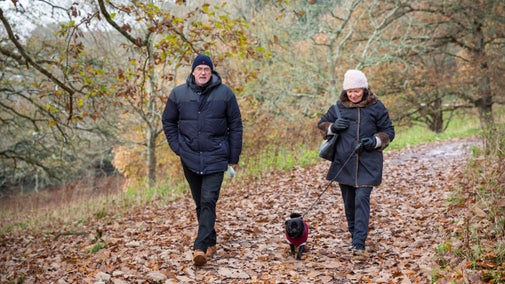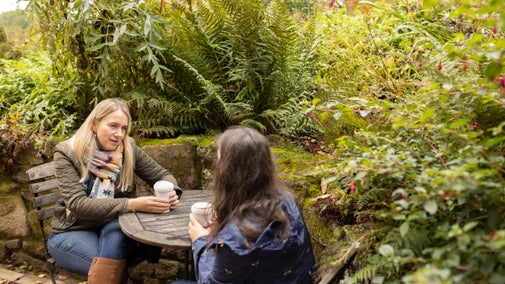
Discover more at Killerton
Find out when Killerton is open, how to get here, the things to see and do and more.

Explore the woods, orchards, gardens and a Grade II-registered parkland on Killerton’s vast estate. You’ll also discover a wide range of habitats hosting all sorts of wildlife throughout the year, including four species of owl, newts, 13 species of bat and 30 species of butterfly.
As a West Country estate, Killerton of course has many acres of traditional orchard. The estate’s orchards provide pollen and fruit to countless insects as well as bountiful apple crops every year. The good news is, the crop goes into making Killerton’s award-winning cider – why not buy some at the shop to taste for yourself?
As you stroll through the estate you’ll see roaming Highland cattle. These long-haired cows graze the parkland, creating a rough grass sward. This is perfect for small mammals and insects, which in turn provide food for lots of birds and bats.
Look down as you walk and you might spot some of the many species of saproxylic beetle resident here, which specialise in eating decaying wood. There are also some rare fungi – some species are associated with the old trees and deadwood in the park.
Don’t miss Killerton’s impressive collection of veteran and ancient trees. You’ll find most of them in the parkland and the garden, but they’re also dotted across the entire estate in fields and hedges.
These trees are not only beautiful but their decaying wood also creates a whole network of biodiversity that benefits the local habitat.

Explore the large areas of woodland at Killerton – including Ashclyst Forest and Danes Wood – on foot, by bike or on horseback.
Killerton welcomes lots of butterflies and you’ll find many species of butterfly in Ashclyst Forest in particular. White admiral, silver-washed fritillary, pearl-bordered fritillary and small pearl-bordered fritillary are just some of the rarer species to see here. Keep your eyes peeled for the bat and bird species that live in the forest too.
Wander through Danes Wood, a small, enchanting woodland that’s a haven for nature. Home to ancient chestnut and oak trees, this is a wonderful place to get off the beaten track for a dog walk or quiet stroll in any season.
In summer stop and listen to the songbirds and look out for buzzards wheeling overhead. Autumn reveals a landscape on fire as the leaves change to red and gold. And in the spring the wood bursts to life with snowdrops and then bluebells carpeting the forest floor.
The serene forest glades hide a restless past, as the wood was reportedly named after Viking raiders who camped here centuries ago. Danes Wood is about a 20-minute walk from Killerton estate and has its own small car park.
There are 15 tenanted, working farms on the Killerton estate. The hedges across the farmed estate are vital for linking up different habitats, which helps species of animals and insects move freely across all 6,400 acres.
Killerton’s landscape garden is a great place to spot a variety of wildlife, especially up in its trees, including bats, birds and moths. Parts of the garden are traditional hay meadow and are managed by Killerton’s garden team.
Take a walk through the hay meadow to see abundant native flora, which creates a stunning contrast to the other more formal areas of the garden.
The flower-rich hay is also vital for the bats, bees and other pollinators that feed on them. The hay also helps support local farmers, who use it to feed their livestock in autumn.

If you’re very lucky, you might spot a dormouse amidst the hazel coppice stands on the estate between April and October, when the tiny rodents are active. Killerton has a healthy population of dormice which are monitored and encouraged by a team of rangers.
Keep your eyes peeled around ancient woodland and hedgerows, which is their preferred habitat. They also tend to stay high among tree branches and rarely come to the ground.
Though you’re unlikely to see them during the day, bats live in the woodland, farmhouses and barns at Killerton. They’re very welcome here, as they’re a sign of a green and healthy environment. Three particularly exciting species for Devon are resident on the estate: the lesser horseshoe, greater horseshoe and barbastelle.
Nestled in Broadclyst Village, within the Killerton estate you will find Clyston Mill. Visit this historic watermill to discover how the mill harnessed the power of water to grind the farmer's grain. The waterwheel is currently undergoing conservation work and so is unable to turn. For more details see the Clyston Mill website.
There's so much history on the estate - a number of the tenanted cottages have historic features. Here's Marker's Cottage and an interior tour that allows us to share the painted screen in the living room. Click on the link to enjoy the tour.

Find out when Killerton is open, how to get here, the things to see and do and more.

Find out about walking, cycling, orienteering and horse riding at Killerton.

Discover what to see and do in Killerton's diverse garden. There’s plenty of space for walks and adventure at this country estate near Exeter.

Killerton is a two pawprint rated place. With miles of paths and tracks to explore, dogs love walkies at Killerton. Find out the best dog-friendly walking routes and where they can run off the lead.

Horse riders can explore Killerton, Devon thanks to the miles of permissive bridleways that take in Danes Wood, Killerton Park and Ashclyst Forest.

Stop by the Stables Coffee Shop for some refreshments, before browsing for gifts and souvenirs in the National Trust shop or second-hand bookshop.

Plan a visit to one of the special countryside places in our care and discover the benefits of being in the great outdoors. Pack your walking boots and get ready to explore woodlands, valleys and rivers.

Explore some of the finest landscapes in our care on coastal paths, accessible trails, woodland walks and everything in between. Find the best places to walk near you.

There's a network of woodland paths and trails to await you in Devon from riverside walks to gentle hill climbs with far-reaching views. Keep the family interested this winter with a visit to Devon.